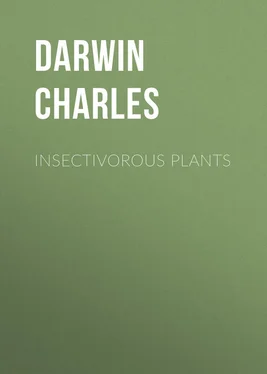Charles Darwin - Insectivorous Plants
Здесь есть возможность читать онлайн «Charles Darwin - Insectivorous Plants» — ознакомительный отрывок электронной книги совершенно бесплатно, а после прочтения отрывка купить полную версию. В некоторых случаях можно слушать аудио, скачать через торрент в формате fb2 и присутствует краткое содержание. Жанр: foreign_antique, foreign_prose, на английском языке. Описание произведения, (предисловие) а так же отзывы посетителей доступны на портале библиотеки ЛибКат.
- Название:Insectivorous Plants
- Автор:
- Жанр:
- Год:неизвестен
- ISBN:нет данных
- Рейтинг книги:5 / 5. Голосов: 1
-
Избранное:Добавить в избранное
- Отзывы:
-
Ваша оценка:
- 100
- 1
- 2
- 3
- 4
- 5
Insectivorous Plants: краткое содержание, описание и аннотация
Предлагаем к чтению аннотацию, описание, краткое содержание или предисловие (зависит от того, что написал сам автор книги «Insectivorous Plants»). Если вы не нашли необходимую информацию о книге — напишите в комментариях, мы постараемся отыскать её.
Insectivorous Plants — читать онлайн ознакомительный отрывок
Ниже представлен текст книги, разбитый по страницам. Система сохранения места последней прочитанной страницы, позволяет с удобством читать онлайн бесплатно книгу «Insectivorous Plants», без необходимости каждый раз заново искать на чём Вы остановились. Поставьте закладку, и сможете в любой момент перейти на страницу, на которой закончили чтение.
Интервал:
Закладка:
The little masses of aggregated matter are of the most diversified shapes, often spherical or oval, sometimes much elongated, or quite irregular with thread- or necklace-like or club-formed projections. They consist of thick, apparently viscid matter, which in the exterior tentacles is of a purplish, and in the short distal tentacles of a greenish, colour. These little masses incessantly change their forms and positions, being never at rest. A single mass will often separate into two, which afterwards reunite. Their movements are rather slow, and resemble those of Amoebae or of the white corpuscles of the blood. We may, therefore, conclude that they consist of protoplasm. If their shapes are sketched at intervals of a few minutes, they are invariably seen to have undergone great changes of form; and the same cell has been observed for several hours. Eight rude, though accurate sketches of the same cell, made at intervals of between 2 m. or 3 m., are here given (fig. 7), and illustrate some of the simpler and commonest changes. The cell A, when first sketched, included two oval masses of purple protoplasm touching each other. These became separate, as shown at B, and then reunited, as at C. After the next interval a very common appearance was presented – D, namely, the formation of an extremely minute sphere at one end of an elongated mass. This rapidly increased in size, as shown in E, and was then re-absorbed, as at F, by which time another sphere had been formed at the opposite end.
The cell above figured was from a tentacle of a dark red leaf, which had caught a small moth, and was examined under water. As I at first thought that the movements of the masses might be due to the absorption of water, I placed a fly on a leaf, and when after 18 hrs. all the tentacles were well inflected, these were examined without being immersed in water. The cell here represented (fig. 8) was from this leaf, being sketched eight times in the course of 15 m. These sketches exhibit some of the more remarkable changes which the protoplasm undergoes. At first, there was at the base of the cell 1, a little mass on a short footstalk, and a larger mass near the upper end, and these seemed quite separate. Nevertheless, they may have been connected by a fine and invisible thread of protoplasm, for on two other occasions, whilst one mass was rapidly increasing, and another in the same cell rapidly decreasing, I was able by varying the light and using a high power, to detect a connecting thread of extreme tenuity, which evidently served as the channel of communication between the two. On the other hand, such connecting threads are sometimes seen to break, and their extremities then quickly become club-headed. The other sketches in fig. 8 show the forms successively assumed.
Shortly after the purple fluid within the cells has become aggregated, the little masses float about in a colourless or almost colourless fluid; and the layer of white granular protoplasm which flows along the walls can now be seen much more distinctly. The stream flows at an irregular rate, up one wall and down the opposite one, generally at a slower rate across the narrow ends of the elongated cells, and so round and round. But the current sometimes ceases. The movement is often in waves, and their crests sometimes stretch almost across the whole width of the cell, and then sink down again. Small spheres of protoplasm, apparently quite free, are often driven by the current round the cells; and filaments attached to the central masses are swayed to and fro, as if struggling to escape. Altogether, one of these cells with the ever changing central masses, and with the layer of protoplasm flowing round the walls, presents a wonderful scene of vital activity.
[Many observations were made on the contents of the cells whilst undergoing the process of aggregation, but I shall detail only a few cases under different heads. A small portion of a leaf was cut off, placed under a high power, and the glands very gently pressed under a compressor. In 15 m. I distinctly saw extremely minute spheres of protoplasm aggregating themselves in the purple fluid; these rapidly increased in size, both within the cells of the glands and of the upper ends of the pedicels. Particles of glass, cork, and cinders were also placed on the glands of many tentacles; in 1 hr. several of them were inflected, but after 1 hr. 35 m. there was no aggregation. Other tentacles with these particles were examined after 8 hrs., and now all their cells had undergone aggregation; so had the cells of the exterior tentacles which had become inflected through the irritation transmitted from the glands of the disc, on which the transported particles rested. This was likewise the case with the short tentacles round the margins of the disc, which had not as yet become inflected. This latter fact shows that the process of aggregation is independent of the inflection of the tentacles, of which indeed we have other and abundant evidence. Again, the exterior tentacles on three leaves were carefully examined, and found to contain only homogeneous purple fluid; little bits of thread were then placed on the glands of three of them, and after 22 hrs. the purple fluid in their cells almost down to their bases was aggregated into innumerable, spherical, elongated, or filamentous masses of protoplasm. The bits of thread had been carried some time previously to the central disc, and this had caused all the other tentacles to become somewhat inflected; and their cells had likewise undergone aggregation, which however, it should be observed, had not as yet extended down to their bases, but was confined to the cells close beneath the glands.
Not only do repeated touches on the glands 7 7 Judging from an account of M. Heckel's observations, which I have only just seen quoted in the 'Gardeners' Chronicle' (Oct. 10, 1874), he appears to have observed a similar phenomenon in the stamens of Berberis, after they have been excited by a touch and have moved; for he says, "the contents of each individual cell are collected together in the centre of the cavity."
and the contact of minute particles cause aggregation, but if glands, without being themselves injured, are cut off from the summits of the pedicels, this induces a moderate amount of aggregation in the headless tentacles, after they have become inflected. On the other hand, if glands are suddenly crushed between pincers, as was tried in six cases, the tentacles seem paralysed by so great a shock, for they neither become inflected nor exhibit any signs of aggregation.
Carbonate of Ammonia. – Of all the causes inducing aggregation, that which, as far as I have seen, acts the quickest, and is the most powerful, is a solution of carbonate of ammonia. Whatever its strength may be, the glands are always affected first, and soon become quite opaque, so as to appear black. For instance, I placed a leaf in a few drops of a strong solution, namely, of one part to 146 of water (or 3 grs. to 1 oz.), and observed it under a high power. All the glands began to darken in 10 s. (seconds); and in 13 s. were conspicuously darker. In 1 m. extremely small spherical masses of protoplasm could be seen arising in the cells of the pedicels close beneath the glands, as well as in the cushions on which the long-headed marginal glands rest. In several cases the process travelled down the pedicels for a length twice or thrice as great as that of the glands, in about 10 m. It was interesting to observe the process momentarily arrested at each transverse partition between two cells, and then to see the transparent contents of the cell next below almost flashing into a cloudy mass. In the lower part of the pedicels, the action proceeded slower, so that it took about 20 m. before the cells halfway down the long marginal and submarginal tentacles became aggregated.
We may infer that the carbonate of ammonia is absorbed by the glands, not only from its action being so rapid, but from its effect being somewhat different from that of other salts. As the glands, when excited, secrete an acid belonging to the acetic series, the carbonate is probably at once converted into a salt of this series; and we shall presently see that the acetate of ammonia causes aggregation almost or quite as energetically as does the carbonate. If a few drops of a solution of one part of the carbonate to 437 of water (or 1 gr. to 1 oz.) be added to the purple fluid which exudes from crushed tentacles, or to paper stained by being rubbed with them, the fluid and the paper are changed into a pale dirty green. Nevertheless, some purple colour could still be detected after 1 hr. 30 m. within the glands of a leaf left in a solution of twice the above strength (viz. 2 grs. to 1 oz.); and after 24 hrs. the cells of the pedicels close beneath the glands still contained spheres of protoplasm of a fine purple tint. These facts show that the ammonia had not entered as a carbonate, for otherwise the colour would have been discharged. I have, however, sometimes observed, especially with the long-headed tentacles on the margins of very pale leaves immersed in a solution, that the glands as well as the upper cells of the pedicels were discoloured; and in these cases I presume that the unchanged carbonate had been absorbed. The appearance above described, of the aggregating process being arrested for a short time at each transverse partition, impresses the mind with the idea of matter passing downwards from cell to cell. But as the cells one beneath the other undergo aggregation when inorganic and insoluble particles are placed on the glands, the process must be, at least in these cases, one of molecular change, transmitted from the glands, independently of the absorption of any matter. So it may possibly be in the case of the carbonate of ammonia. As, however, the aggregation caused by this salt travels down the tentacles at a quicker rate than when insoluble particles are placed on the glands, it is probable that ammonia in some form is absorbed not only by the glands, but passes down the tentacles.
Читать дальшеИнтервал:
Закладка:
Похожие книги на «Insectivorous Plants»
Представляем Вашему вниманию похожие книги на «Insectivorous Plants» списком для выбора. Мы отобрали схожую по названию и смыслу литературу в надежде предоставить читателям больше вариантов отыскать новые, интересные, ещё непрочитанные произведения.
Обсуждение, отзывы о книге «Insectivorous Plants» и просто собственные мнения читателей. Оставьте ваши комментарии, напишите, что Вы думаете о произведении, его смысле или главных героях. Укажите что конкретно понравилось, а что нет, и почему Вы так считаете.












